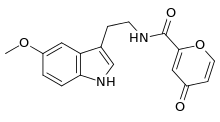Piromelatine
Piromelatine (Neu-P11) is a multimodal sleep drug under development by Neurim Pharmaceuticals. It is an agonist at melatonin MT1/MT2 and serotonin 5-HT1A/5-HT1D receptors. Neurim is conducting a phase II randomized, placebo controlled trial of cognitive and sleep effects in Alzheimer's disease.
 | |
| Identifiers | |
|---|---|
| |
| CAS Number | |
| PubChem CID | |
| ChemSpider | |
| UNII | |
| CompTox Dashboard (EPA) | |
| Chemical and physical data | |
| Formula | C17H16N2O4 |
| Molar mass | 312.325 g·mol−1 |
| 3D model (JSmol) | |
| |
| |
Results of a phase II trial on insomnia in 120 adults were announced in 2013, finding piromelatine 20/50 mg improved sleep over 4 weeks vs placebo.[1] Phase 1A/1B studies in 2011, showed safe dose-dependent improvement in sleep.[2] Pre-clinical studies showed antinociceptive[3] antihypertensive[4] and cognitive benefits[5] in rat disease models of pain, hypertension, and Alzheimer's disease.
See also
References
- "Neurim Pharmaceuticals Announces Positive Phase 2 Clinical Trial Results of Piromelatine for the Treatment of Insomnia". Neurim Pharmaceuticals. 18 February 2013.
- "Neurim Pharmaceuticals Announces Positive Results From Phase I and Ib Clinical Trials With Neu-p11, a Sleep Maintenance Drug". Neurim Pharmaceuticals. 24 July 2011.
- Liu YY, Yin D, Chen L, Qu WM, Chen CR, Laudon M, et al. (October 2014). "Piromelatine exerts antinociceptive effect via melatonin, opioid, and 5HT1A receptors and hypnotic effect via melatonin receptors in a mouse model of neuropathic pain". Psychopharmacology. 231 (20): 3973–85. doi:10.1007/s00213-014-3530-5. PMID 24700387. S2CID 815868.
- Huang L, Zhang C, Hou Y, Laudon M, She M, Yang S, et al. (September 2013). "Blood pressure reducing effects of piromelatine and melatonin in spontaneously hypertensive rats". European Review for Medical and Pharmacological Sciences. 17 (18): 2449–56. PMID 24089222.
- He P, Ouyang X, Zhou S, Yin W, Tang C, Laudon M, Tian S (June 2013). "A novel melatonin agonist Neu-P11 facilitates memory performance and improves cognitive impairment in a rat model of Alzheimer' disease". Hormones and Behavior. 64 (1): 1–7. doi:10.1016/j.yhbeh.2013.04.009. PMID 23651610. S2CID 205806140.
This article is issued from Wikipedia. The text is licensed under Creative Commons - Attribution - Sharealike. Additional terms may apply for the media files.